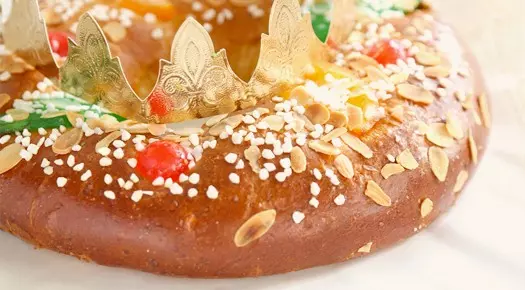Le délicieux Gâteau des Rois en Provence

Epiphany in Provence and its traditional "King Cake"
Once again in Provence, we don't like to do things like everyone else , and at Epiphany, the tradition isn't to eat the galette des rois (king cake) with its frangipane filling, which we dismiss as "the Parisian galette" or simply "the Parisian," deeming it too bland. The Provençal delicacy of this January period is called the "gâteau des rois" (king cake) or "la couronne des rois" (king's crown) . It's a sweet brioche shaped like a circle, revealing a generous, round form delicately flavored with orange blossom and studded with candied fruit, which delights the palates of Provençal people at the beginning of the year.
History and Origin of the King Cake
A Roman tradition...
This Provençal tradition is believed to have originated from pagan festivals celebrated by the Romans called "Saturnalia." This festival was an opportunity to get drunk and break down social barriers between masters and servants to celebrate together the return of the sun and the beginning of longer days . A real bean was hidden inside a cake filled with figs, dates, and honey, which was divided equally among everyone regardless of their social standing. The person who found the bean was crowned king for a day and could do as they pleased.
...which is becoming a Christian tradition
Like many other pagan festivals, the Christian religion adopted this tradition , and today it is customary to enjoy the King Cake on January 6th . This date corresponds to the arrival of the Three Wise Men to the infant Jesus , from whom the cake takes its name. The candied fruits , a specialty of Provence and more specifically of the town of Apt in the Luberon, represent, in the King's crown, the jewels that the Wise Men offered as gifts to Jesus Christ.
The Epiphany tradition in Provence today
Today in Provence, the tradition surrounding the King Cake remains deeply rooted in Provençal customs . It is still enjoyed on January 6th or the first Sunday of January, but not only then... In Provence, the rich gastronomy of our region makes us great gourmets, and we rarely limit ourselves to eating a King Cake just once a month. This indulgence generally extends throughout January and even until Candlemas, which marks the end of the Christmas festivities. It can be found in most bakeries throughout Provence.
The nativity scene is a true tradition in Provence, with a series of small ceremonies taking place in homes. On December 24th, the baby Jesus is placed in the manger, which is surrounded from the beginning of December by santons, small clay figurines that represent a genuine local craft in Provence (see the article "Celebrating Christmas in Provence" ). It is only on January 6th, the Feast of the Epiphany, that the santons representing the Three Wise Men and their gifts can be placed in front of the baby Jesus in the manger.
In Provence, generosity reigns , and not one, but two beans will be hidden in the King Cake . One is a special bean that can be eaten, and the other is a small figurine. Whoever finds the bean is crowned king, and whoever discovers the figurine becomes the king's subject. This subject is then responsible for buying the next King Cake for everyone.
Traditionally, the youngest child goes under the table and distributes the slices blindly to prevent cheating with the size of the slices and the beans. One more slice is always cut than the number of people present; this is called "the poor man's slice".
The Recipe for King Cake
At Slow Provence we offer you a simple recipe to make a King Cake (for 6 people):
|
Ingredients |
Preparation |
|
Take the butter out of the refrigerator some time before starting the preparation so that it softens. Dissolve the yeast in 1/2 a glass of lukewarm water and set aside. Wash the orange and grate the zest. Mix the flour with 4 egg yolks, then the sugars. Cut the softened butter into small pieces and moisten it with the yeast. Mix with the preparation by hand, kneading until a consistent dough is obtained. Add orange blossom water and orange zest to the dough Slide the beans in and form a ball. Leave to rise for 6 hours in a cool place. Preheat the oven to 200°C (Thermostat 6/7). Flatten the dough slightly by hand. Make a hole in the middle to form the crown and place it on a pre-oiled baking sheet. Brush the crown with the last egg yolk. Garnish the wreath with candied fruit, which you can also glaze with agave syrup, maple syrup or honey. Bake at 200°C for 30 minutes, keeping a close eye on it. Once out of the oven, you can sprinkle it with coarse or powdered sugar. Don't forget to order 2 crowns! |
Fancy enjoying the gastronomy of Provence during your holidays? Discover all our holiday rentals in Provence at the foot of Mont Ventoux. Charm and authenticity await you for a successful holiday under the southern French sun .


 Français
Français
 English
English
 Deutsch
Deutsch
 Nederland
Nederland
